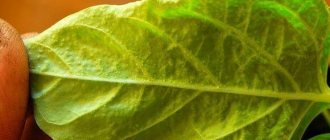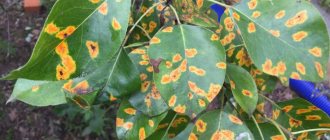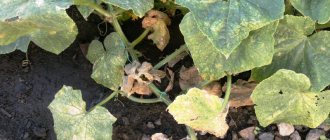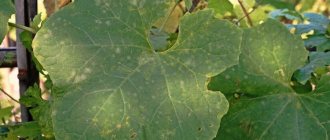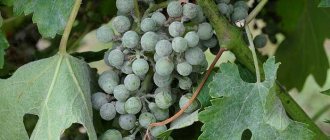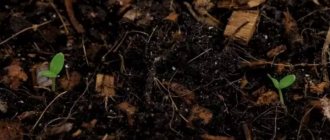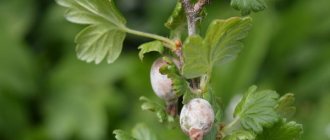Rust
A dangerous fungal disease affects not only leaves. Fruits and shoots also become victims.
The first manifestations of rust become noticeable in late spring. At first these are small reddish spots covering the foliage. If measures are not taken, then by autumn the disease reaches its peak. Orange growths appear on the inside of the leaf blade, inside which spores of the pathogen fungus develop. Ignoring the disease can ultimately lead to the following consequences:
- disruption of the photosynthesis process;
- slowing down shoot growth;
- thickening and deformation of branches;
- reduction in yield or complete cessation of fruiting;
- general weakening of the tree;
- decreased immunity and frost resistance;
- death of the tree.
Rust on a pear: photo.
Treatment
To cure a pear from a disease, you can use chemicals, folk remedies, and pruning infected shoots.
If the disease is at an early stage and a small number of branches are affected, removing the lesions may be the most effective method. Pruning is carried out by capturing 5-10 cm of healthy tissue, and the cut areas are treated with copper sulfate.
Among the chemicals, the most effective in the fight against rust are:
- Horus;
- Rayok;
- Gamair;
- Alirin;
- Cumulus DF;
- Thiovit jet;
- Polyram DF;
- Delan;
- Tercel;
- Bordeaux mixture.
Among the proven folk recipes, the most often used are:
- urea solution;
- mullein infusion;
- wood ash decoction;
- marigold tincture;
- a solution of soda ash and soap.
Neoplasms on the root system (root cancer)
The dangerous pathogen “Agrobacterium tumefaciens stevens” infects the underground part of the pear. As a result, shapeless galls and growths appear on the root collar and lateral branches. As the infection progresses, bumps form near the tree trunk. This indicates a cancerous infection of the root system. In autumn, the growths collapse and rot, which leads to the release of a huge number of harmful microorganisms into the soil. They remain active for 3-4 years.
To eliminate the problem, a careful inspection of all the trees in the garden is carried out. Affected seedlings are removed, young ones are uprooted. If there is a small number of growths, cut off the side part of the root system and disinfect with copper sulfate (100 g of product is enough for 10 liters). Periodically fertilize the soil with phosphorus-potassium mixtures.
The disease can also be overcome using traditional methods. The following solutions are used for spraying:
- potassium permanganate and water;
- table salt with iodine;
- diluted washing powder;
- low concentration of moonshine;
- ash with soap (take 300 g for 4 liters).
Ready-made fungicides such as “Raek”, “Horus”, “Strobi”, “Skor”, “Fitolavin” are no less effective. The packaging indicates the proportions, as well as the frequency of processing of the fruit crop.
Trees affected by cancer lose productivity and resistance to cold.
Pear gall mite
A sign of the presence of a pest on a pear is the appearance of yellow-brown swellings on the surface of the leaf plate. Over time, the bumps increase in size and may merge with each other.
After the mite has sucked out all the nutrients from the leaf it is on, it moves to another. And the affected leaf dries out and cracks.
If you do not start fighting the pest in time, the following may happen to the infected plant:
- foliage dries out prematurely;
- the process of photosynthesis is disrupted;
- fruit growth slows down;
- productivity decreases.
Manifestation of gall mite.
Treatment
In case of severe damage, only treatment with special preparations will help cope with the insect. This is best dealt with by products containing organophosphorus compounds or chlorine, such as:
- Karbofos;
- Akrexa;
- Fufanon;
- Nitrafen.
To get rid of ticks that could have overwintered on the pear, Inta-vir is used. Treatment with the drug is carried out before the start of sap flow.
To reduce the number of insects in combination with chemicals, agrotechnical measures should be carried out, such as:
- fertilizing with mineral fertilizers;
- removal of old, exfoliated bark;
- whitewashing with lime mortar;
- cleaning the tree trunk from weeds, fallen leaves and fruits.
Traditional methods of insect control also have a good effect
- spraying with dandelion infusion;
- treatment with potato infusion;
- spraying with marigold tincture.
Viral diseases of pear and their treatment
Viral diseases are the most dangerous for pears. They attack leaves, trunk and fruits. Such diseases cannot be treated. It is recommended to remove the affected tree from the site to protect the garden from the spread of the virus.
Mosaic disease
If the pear leaves are light green and do not gain color, then this is a sign of mosaic disease. In this case, there are lighter and darker spots on the leaf plate. The lesion is viral in nature and spreads through the instrument, during vaccination, along with insects.
There is no cure for mosaic disease. The tree will have to be uprooted and burned. It is also recommended to disinfect the soil and garden tools.
Important! In the future, disease-resistant varieties are used for planting. Purchase healthy seedlings from trusted suppliers.
Witch's broom
According to the description with photographs, witch's broom pear disease appears more often on older trees. The virus provokes the development of many side shoots. They usually appear in the second half of summer. At the same time, the growth of the pear slows down, the fruits become smaller, lose their taste and color.
Various treatment methods do not bring positive results. The sick tree is uprooted. Therefore, special attention is paid to disease prevention - combating aphids and other virus carriers, disinfecting tools, and choosing resistant hybrids.
Wood warts
The first signs of the disease are flat, wide furrows or brown necrotic spots on the trunk. They occur in places where the grafted variety grows together with the rootstock. Affected shoots often break. At the same time, dark lines, scars and swellings are visible on the trunk. As a result, the leaves of the pear turn red ahead of time, they become chlorotic and fall off. Treatment of grooves does not bring results; the tree has to be removed from the site.
Leaf gall aphid
When aphids are infested, galls appear on the surface of pear leaves. The growths may be yellow or burgundy in color. A characteristic sign of the presence of aphids on a tree is also a sticky liquid on the leaves and fruits.
Numerous colonies of aphids can destroy the crop and the entire tree. They feed on juices from inflorescences and foliage, which causes them to dry out, curl and deform. Covering leaves and fruits with sweet honeydew also becomes a breeding ground for sooty fungus.
Treatment
To get rid of aphids, you should pay attention to the presence of ants in the garden. They are most often breeders of small insects, so you need to get rid of them first.
You can also reduce the number of pests by attracting their natural enemies to the site: birds, lacewings and ladybugs. This can be done with the help of fragrant herbs and feeders.
Proven folk remedies are popular among gardeners , such as:
- treatment with soap solution;
- spraying with tincture of potato tops;
- irrigation with onion tincture;
- spraying with tobacco infusion;
- treatment with alcohol solution.
In case of severe damage, only chemicals will help cope with the pest. The most effective drugs are:
- Fufanon;
- Aktelik;
- Aktara;
- Fitoverm;
- Spark;
- Tanrek.
Aphids on a pear: photo.
How to act
When identifying a disease, you should follow the following step-by-step instructions:
- Identify and recognize the type of disease.
- Carry out “treatment” of the tree with the source of infection.
- For preventative purposes, treat other stone fruits and pome trees in the garden.
- Notify your dacha neighbors and owners of neighboring plots about the possibility of the disease spreading and the need to take measures to prevent its outbreak.
- Treatment with chemicals must be carried out strictly according to the manufacturer’s recommendations, taking into account the timing and dosage of the component. This point is extremely important, since failure to follow the recommendations can lead to the harvesting of a potentially dangerous crop with pesticides that have not been removed.
Related article:
How to fight aphids on currants?
Pear gall midge
The insect sucks nutrients from leaves, fruits, ovaries and inflorescences. As a result of the life activity of the pest, galls are formed on the surface of the affected areas. Affected foliage dries out and curls prematurely.
If you do not start fighting insects in a timely manner, this can lead to the loss of the entire crop.
Treatment
To combat insects, it is necessary to remove curled leaves from the pear, as they contain nests of the pest. During the period when the larvae are active, they can be shaken off the tree onto a pre-spread litter.
The most effective method of controlling gall midges is treatment with insecticides , namely:
- Antio;
- Gardona;
- Dursban;
- Zolon;
- Karbofos;
- Metathion;
- Metaphos;
- Nexion;
- Phosfamide;
- Chlorophos.
Treating pears with products against gall aphids can also have an effect on pear gall midge.
Pear gall midge: photo.
Rules for treating pears against pests in the fall
Autumn is perhaps the best period for treating pears for pests. Don't think that most of them will die in winter. If in the summer traces of the vital activity of pear mites or aphids were noticed on the trees, then the trees are sprayed with insecticides such as Acrobat, Inta-Vir or Karate.
Treatment is carried out by spraying or spraying a solution prepared according to the instructions.
Prevention measures
To prevent the appearance of unpleasant symptoms, it is necessary to maintain the health and strong immunity of the tree. This can be achieved by following these recommendations:
- regularly carry out sanitary pruning of pear trees;
- feed the plant with complex fertilizers;
- keep the tree trunk clean;
- carry out preventive treatments with products to protect against pests and diseases;
- regularly loosen the soil around the tree trunk;
- remove exfoliated areas of bark and growths from the trunk and skeletal branches;
- whitewash the trunk annually with lime mortar.
Rules for processing pears in autumn for winter
Almost all treatments are carried out by generously spraying preparations on the shoots and spraying or watering the root circle with them. It is better to use a garden sprayer with a long hose and a large capacity container.
Pears are processed in dry and windless weather. It is advisable that there is no precipitation in the next 24 hours. In this case, the solution will have time to absorb and activate its effect.
To perform work, closed clothing and personal protective equipment are used: gloves, goggles, respirators. Before processing, you should carefully read the instructions for use of a particular drug and be careful. After all, large areas will have to be processed.
Bacterial infections
Bacteria are single-celled organisms. They have their own metabolism and live full lives. Bacteria use living organisms as a feeding medium and a place of reproduction. There is only one effective remedy against them - antibiotics.
Bacterial diseases are characterized by the following leaf changes:
- spots of various colors;
- dry ends;
- withering.
Tumors, growths, tubercles on the bark, and rot are characteristic.
There are few bacterial diseases of pear, but all of them are difficult to treat and quickly lead to the death of the plant:
- bacteriosis or bacterial burn;
- bacterial necrosis of the cortex;
- bacterial root cancer.
Bacterial burn
The disease manifests itself in the form of blackening and drying of leaves and young shoots. At the same time, the leaves curl, but do not fall off. In addition to shoots and leaves, flowers, fruits, trunks, and roots are affected. Mostly young trees are affected.
When the disease manifests itself, be sure to cut out the dried branches. Spring treatment of pears with copper-containing preparations is necessary. The best way to treat a bacterial burn is an antibiotic solution.
You can use streptomycin; one ampoule is enough for 10 liters. This is enough to treat 10 trees under five years old. Varieties resistant to bacterial diseases recover after a year.
Bacterial bark cancer
This disease appears in the spring, causing the buds to turn brown and dry out. The bark near them also dies. The young shoot turns black, and black spots appear on the leaves from the end of the leaf.
The branches and trunk swell in places and then crack. The bark lifts up and curls. The wood rots and gives off a rotten smell. The affected areas are cut out and disinfected with 17% copper sulfate.
Bacterial root cancer
The fungus provokes increased division of root cells and the formation of tumors and growths. And the appearance of pimples on the roots ends with the growth of bumps up to 12 cm in diameter.
Tumors affecting the central root or root collar lead to the rapid death of the pear. Dead parts of the root lead to contamination of the soil with cancer viruses. The diseased tree must be dug up by the roots and burned, and the soil must be etched with a 2% bleach solution.
Bacterial diseases of pears in the country can be slowed down by treatments, but the likelihood of their return is high. To avoid spreading the infection, diseased trees are uprooted and burned.
